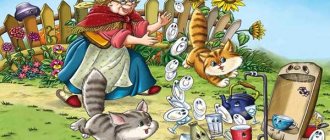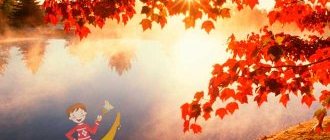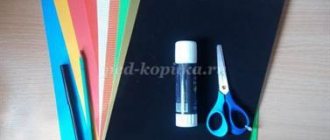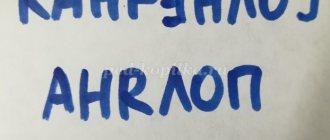Quiz on the works of Bianchi for children of the preparatory group
Quiz based on the works of V. Bianchi for children in the preparatory school group.
Author: Gulnaz Mansurovna Minachetdinova, senior teacher of MBDOU “Kindergarten No. 22 “Zhuravlyonok”, Novocheboksarsk, Chuvash Republic. Description: The summary of the quiz based on the works of V. Bianchi is intended for a preparatory group (children from 6 to 7 years old). The content is aimed at consolidating knowledge of the content of fairy tales and stories by V. Bianchi. This event can be held as a final event on the works of a children's writer. Goal: To instill interest in fiction about nature. Objectives: Continue to form natural history ideas through the works of V. Bianchi; Develop memory, attention, logical thinking, ability to analyze, draw conclusions, generalize; Develop coherent speech; Cultivate an interest in nature. Preliminary work: reading (perception) of V. Bianchi’s works “The First Hunt”, “How an Ant Hurried Home”, “The Fox and the Mouse”, “Terenty-Gaterev”, “Tails”, “Forest Houses” and others, looking at illustrations. Progress: Educator: Nature keeps many different mysteries and secrets. One of those writers who could solve these riddles and unravel the mysteries was Vitaly Bianchi. This wonderful writer loved nature and knew how to describe it in his fairy tales and stories. Let's remember some of them. To do this, I suggest you divide into 2 teams. Each team will perform its task. For each correct answer, the team receives a chip. The team that gets the most chips will win. Task 1: “The Main Character” Educator: Choose the correct one from the three proposed answers. Team 1: “Who is the main character in the story “The First Hunt”?” puppy kitten little fox Team 2: “Which tree became the mansion for the animals in the story “Teremok”” oak spruce birch 2nd task: “Remember the names of the works” Educator: 1. “Forest …” -teremochki -houses -huts Answer: “Forest houses” 2. “The first ...” - walk - hunt - exhibition Answer: “First hunt” 3. “Who does what ...?” -screams -sings -whistles Answer: “Who sings with what?” 4. “Fox and...” -mouse -hamster -mole Answer: “Fox and mouse” 5. “Bathing...” -hares -bear cubs -fox cubs Answer: “Bathing bear cubs” 6. “Terenty...” -raven -grouse -owl Answer: “Terenty - Teterev” 3rd task “Riddles in fairy tales and stories” Educator: Try to guess from the passage who it is, what it is and the title of the work? Team 1: What did the fly ask from the man in the fairy tale “Tails” Answer: “Make me a tail?” Team 2: Whose nose was better in the fairy tale “Whose nose is better?” Answer: “It remains unknown whose nose is better.” Task 4 “Who eats what?” Educator: In the fairy tale “Whose nose is better?”? V. Bianki told what food the birds eat. Listen to the task. Team 1 - Name the food that crossbill eats. Team 2 - Name the food that the grosbeak eats. Task 5 Game “Who is bigger?” Educator: Answer the question: “Who is smaller?” Team 1 – fox or mouse Team 2 – mouse or owl 6 task “Who is this?” Educator: Try to guess who it is from the description? Team 1: “Worm - like a worm, only in front - legs and in back - legs.” (caterpillar-land surveyor, “Like an ant hurried home”) Team 2: “He pushes off, pushes off with his legs and rolls and glides through the water as if on ice.” (water strider, “Like an ant hurried home”). Task 7 “How it all began” Educator: Try to guess the name of a fairy tale or story from the first lines. Team 1: - “Mouse, little mouse, why is your nose dirty?” (“The Fox and the Mouse”). - “The Ant climbed onto the birch tree. He climbed to the top, looked down, and there, on the ground, his native anthill was barely visible.” (“Like an ant hurried home”) Team 2: “The Old Man is sitting, drinking tea. He doesn't drink empty - he whitens it with milk. An Owl flies past" ("Owl"). - “The puppy is tired of chasing chickens around the yard. I’ll go,” he thinks, “to hunt for wild animals and birds” (“First Hunt”). Final part Educator: Well done guys, you completed all the tasks. Let's count the chips. Counting chips, determining the winning team.
We recommend watching:
KVN “Travel through Fairy Tales” for children 6-7 years old Literary quiz based on Suteev’s fairy tales for children of the preparatory group Quiz based on Pushkin’s fairy tale “The Tale of the Dead Princess and the Seven Knights” for children of the preparatory group Quiz with answers for children of the preparatory group on September 1
Similar articles:
Ecological quizzes for preschoolers 5-6-7 years old
Literary quizzes with answers for preschoolers
Quizzes for children 5-6 years old in kindergarten
Forest travels based on books by Vitaly Bianchi for young library readers
February 11 is the 125th anniversary of the birth of the Russian writer Vitaly Valentinovich Bianchi. For thirty-five years he wrote about the forest. This word often appeared in the titles of his books: “Forest Newspaper”, “Forest Houses”, “Forest Cubs”. Bianchi's stories, short stories, and fairy tales uniquely combined poetry and accurate knowledge. He even called the latter in a special way: non-fairy tales. They don't have magic wands or walking boots, but there are no less miracles there.
The educational carousel “He wrote about the forest” based on “non-fairy tales” by Vitaly Bianchi was organized on February 8 at the Buk library
for children S(K)SHI No. 1. The children got acquainted with the interesting life of the writer and his works about nature. We learned that Bianchi’s most famous book was “The Forest Newspaper.” There was no other like this. The children enjoyed looking at the books “Mouse Peak,” “First Hunt,” and The Adventures of Ant.” After a loud reading of the story “Who Sings What?” The students actively answered questions about the story. And everyone really liked the cartoon “High Hill” based on Bianchi’s stories.
February 7 in library No. 8
For children from kindergarten No. 80, a lesson was held dedicated to the work of Vitaly Bianchi. During a lesson in the library, kindergarteners figured out how a story differs from a fairy tale, and listened to the story about a deciduous hare in Vitaly Bianki’s story “The Peeled Barrel.” As usual, the children spent part of the lesson coloring the picture, along the way talking about how it’s a pity to find a forest animal, but when you take an animal from its natural habitat, this can have dire consequences.
An ecological journey through the pages of books “Forest Journey with Vitaly Bianchi” was organized on February 8 by Library No. 22
for children MBDOU No. 52. With the children we read the stories “Whose nose is better”, “Tails”, “Forest houses”. Reading these fairy tales and stories, readers think, rejoice, empathize, and are surprised. In conclusion, we played the games “Guess who it is?”, “Riddles from the forest”, “Day/Night”, “What lies in the black box”.
February 7 at the Reader's School class in library No. 20
kids (GKP "Ladushki") made a literary journey through the works of Vitaly Valentinovich Bianki.
“Who Sings What” is a work by Vitaly Bianchi, which is liked by inquisitive children. In it, the author lists many inhabitants of meadows, forests and swamps, tells how and with what help they make their sounds. Who will have the most amazing “musical instrument” in the natural orchestra in their arsenal? We read about this with our children in an entertaining fairy tale. She teaches you to love nature, be observant and look for your own talent even when it seems that there is none at all.
“The First Hunt”: a loud reading and discussion of Vitaly Bianchi’s story was held on February 6 in library No. 13
according to the “Filipok” program for children of kindergarten No. 157.
The children also listened to the wonderful story “The First Hunt”, in which the characters live their ordinary lives, but at the same time speak human language. This combination of fairy tales and reality helps children better understand the life of nature. The fairy tale teaches not to be overly self-confident and to know that all living things in nature know how to defend themselves. After reading and discussing this story, the children vied with each other to talk about their encounters and observations of animals and insects. We also talked about the rules of behavior in the forest.
On February 8, students of grade 2 “B” of school No. 21 took part in the literary and game program “From an ant to an elephant,” which was organized by library No. 9.
During the event, children got acquainted with the writer’s work. The game “Literary Auction” helped to remember as many of the author’s works as possible. With special excitement, the children guessed riddles about forest dwellers and birds. And playing the game “Who Lives Where?” they remembered who lives in the air, in the ground, on the grass, in the trees and in the water.
The stories “Sundew - Mosquito Death” and “Red Hill” were read aloud to the children. At the end of the event, the children made a fairy tale hero out of paper - non-fairy tales.
Extracurricular activity in elementary school. Tales of Bianchi
Extracurricular event “90 years since the writing of fairy tales by V.V.
Bianchi “Forest Houses”, “Whose nose is better?”, “Whose legs are these?”, “Who sings with what?” 1924." Goal: to introduce students to the fairy tales of the great writer V.V. Bianchi “From the North”, “From the East”, “Last Flight” and continue to get acquainted with holidays (non-calendar). Planned results: Personal results: - formation of initial ethical ideas; — the formation of a respectful attitude towards the nature of our country and its modern life; — development of skills to establish and identify cause-and-effect relationships in the surrounding world; — readiness for moral self-improvement, self-development; — the formation of an individual’s internal attitude to act in accordance with his conscience; - education of morality based on freedom of conscience; - awareness of the values of human life. Meta-subject results: - formation of ideas about the world and the surrounding nature;
— achieving the level of reading competence and general speech development necessary for continuing education; — awareness of the integrity of the surrounding world, mastering the basics of environmental literacy, basic rules of moral behavior in the natural world, norms of health-preserving behavior in the natural environment; - mastering accessible ways of studying nature (observation, comparison, classification, etc., obtaining information from surrounding people, in an open information space); Subject results: - understanding of literature as a phenomenon of national and world culture, a means of preserving and transmitting values and traditions; - awareness of the importance of reading for personal development; — developing the need for systematic reading; — understanding the role of reading (introductory, studying, selective, search). Course of extracurricular activities:
Stage of the event:
I. Org. moment - Hello!
I, Anna Olegovna, am very glad to see you! I think each of us loves holidays and birthdays. — What holidays do you know? Name them. (Schoolchildren name some calendar holidays) - Do you think such holidays exist: “Birthday of the book”, “...(so many) years since the publication of the story / novel.” - These are all memorable dates. The teacher conducts a conversation about holidays and memorable dates. II. Main part
1. V.V.
Bianchi is a great writer. Writer's creativity. — We still have a memorable date today. Which one do you think? (Students express their guesses). — Today marks the 90th anniversary of the fairy tales of the great Russian writer Vitaly Valentinovich Bianchi. Previously, all writers and poets tracked holidays and dedicated some of their works to them. These works showed different seasons of the year. Not only people were heroes, but also animals, birds and even insects. Vitaly Valentinovich Bianki, even in his childhood and youth records, managed to accumulate the material of personal impressions and observations, which was later included in the book “Forest Newspaper” - about the continuous cycle of phenomena in living nature. - Think about why the author called his newspaper forest? (It shows the inhabitants of the forest and their life). - Right. Ordinary newspapers write only about people and their affairs. The author, in his newspaper, wrote about the inhabitants of the forest and about their difficult life, full of incidents. Vitaly Bianchi o. Indeed, there are no fewer incidents in the forest than in the city. There is also work going on, there are happy holidays, accidents. It has its own heroes and robbers. But in city newspapers they write little about this, and therefore no one knows all the forest news. Indeed, watching animals is very interesting. Also, it is no less interesting to know about how animals, birds and insects live. This is exactly what the author wrote about in every issue of his newspaper. - Look outside the window. What time of year is it now? (It's autumn now). - Everything is correct. The author dedicated many fairy tales to this time of year. - What month is it now? (November) - What time of year does it belong to? (This is the autumn month). — In the old days, this month was called “half-winter.” - Why do you think people called him that? (Students' assumptions) - At this time there are still sunny days, which all living things on Earth enjoy. You may say: “What mosquitoes and dandelions when it’s November outside?!” But imagine, on a warm November day, black mosquitoes and flies crawl out from under the roots of trees, golden dandelions bloom under your feet, coltsfoot - all the spring flowers! The first snow has melted. It's time for logging. — The month “November” is also called the grandson of September, and the son of October. Who do you think he will be in December? (Students' assumptions). - He is December’s brother. - Think about it when they say: “November with a nail, December with a bridge”? (This saying says that in the month of November they start doing something and only finish it in December. That the work ahead is long and painstaking, taking a lot of time). - You think right! Conversation with students about the great Russian writer V.V. Bianchi, his work. Conversation “November is the autumn month.” 2. Game-competition in groups: “Sayings” Instructions for the game: - Attention! You are offered this task. Some sayings are included on the slide. Your task is to explain the meaning of the proverb you have chosen as quickly and clearly as possible. The most important thing is to explain it correctly. Students are divided into 3 groups. November: October is cold, father, and November will turn it too cold. In November, the sun smiles through tears and “white flies”. November builds bridges without an axe. 3. Reading fairy tales “From the North”, “From the East”, “The Last Flight”. (see Appendix) - Since winter is already on the way and we have wintering and migratory birds, then there must be some more? What kind of birds do you think we are talking about? (Students' assumptions). — Birds come to us from the north and east for the winter. Why do they come to us? (Students' assumptions). — Bianchi answered this question as follows. The teacher reads fairy tales. 4. Game in groups: “Birds in the Forest” Instructions for the game: - Attention! Look at the slide. 12.
3.
4. 5.
6.
It depicts different animals under the numbers. Your task: first, divide into 3 groups; secondly, name (and this must be done as quickly as possible!) all the inhabitants of the forest, write down their names on paper; thirdly, to identify those who remain for the winter in our forest and name them. Students are divided into 3 groups. The screen shows images of different animals, birds, beasts. Task: name the animals and identify those that winter and those that do not winter in the forest.
III. Final part.
- So, why do birds come to us for the winter?
(Birds come to us for the winter, because where they lived before it becomes very cold and hungry). — Look at the slide. It shows some of the birds that come to us from afar. So that you know them and recognize them when you accidentally see them in the forest, I put them on the slide. But remember: if you notice their nests, do not destroy them under any circumstances! Birds work so hard in the fall that they build very strong and reliable nests. Next year, many of them fly to the same place and occupy their native nests. — Vitaly Bianki, who wrote many fairy tales about forest inhabitants, often observed them in the forest himself, noticing something new and surprisingly unusual for himself. From his observations he composed his tales. He could write on behalf of children invented by himself. For example, in the fairy tale “The Last Flight” he writes: In the morning I went for a walk and saw: black mosquitoes were flying everywhere in the snow - on the road, in the bushes, between the trees. Their flight is weak and helpless. They will rise from somewhere below, fly in an arc, as if they were being blown away by the wind, although very quietly, and land on the snow somehow sideways. — The author did not indicate which white mosquitoes he saw. Think about who he meant? (Students' assumptions). — He talks about snowflakes that slowly fall on the Earth in a beautiful white blanket. — In winter, the forest becomes beautiful and as interesting as at any other time of the year. Birds are amazing and interesting creatures, although they don't compare to the affectionate house cat you can play with. Even in our city, watching the local birds, you can notice that they live their own life, their own mind. Conversation between teacher and students: “Birds are amazing and interesting forest inhabitants.” 1. The story “The Crow and the Bread.” - Now I will tell you a story from my personal observations.
Please note that I saw this by accident. Story. Every year, in winter, my grandmother and I make a bird feeder. It turns out very simple - from a bottle. We hang it on a lilac branch growing outside the window. Every year she meets flocks of different birds - both large and small. All of them - both sparrows and tits - frolic merrily, flying from branch to branch. On severely frosty days, a crow will not be afraid to fly in for a visit, which, of course, cannot get into the feeder. Therefore, she usually walks on the ground and collects crumbs that accidentally fall out of the feeder when some very thieving sparrow begins to drive other birds away from the feeder. One day, during very bad weather, a crow flew to our feeder with her crow. They sat down on a nearby tree and began to watch the sparrows and tits fluttering around the feeder - they began to wait for their prey. A little later, a thief sparrow flies in from somewhere and commotion begins. Bread crumbs began to fly in all directions. The crow, waiting for the falling crumbs, quickly and deftly flew to the Earth, found the largest bread crust and began to bury it in the snow. At first my grandmother and I were surprised and thought: “Why does the crow bury bread crust in the snow?!” The little crow is waiting, sitting on a branch.” And then they realized that she cared so much about her chick: the bread crust turned out to be too hard, but in the snow it softened and the crow could easily eat it. Indeed! After waiting a little, the crow quickly and deftly dug up its prey, flew up onto a branch and began to feed the chick. The teacher tells the students a story from the life of a bird. 2. Creative work - Having told you one of my observations, I would like each of you to feed the birds, especially in winter, when it is cold outside. - Now you. Tell us what interesting things you saw or noticed by chance in the life of animals or birds. IV. The result of an extracurricular event.
- So, we did a great job today. What holiday did you celebrate? (Birthday of fairy tales by Vitaly Bianchi). — How old are his fairy tales? (90). — What new birds did you recognize? (Forest birds flying to us for the winter). - Remember their names. (Oriole, crossbill, crimson bee-eater, siskin, goldfinch, redpoll, tufted waxwing). - What else did we talk about? (About sayings). - Name the sayings that you learned for the first time today. (1. October is cold, father, and November will turn cold too. 2. In November, the sun smiles through tears and “white flies.” 3. November builds bridges without an axe.). - Please note that they are all about the month we are going through now. Every year, every month, the forest changes. Its inhabitants also change: birds, animals, insects. The reason for all these changes is the rash actions and actions of a person. Therefore, I encourage you to seek useful and important information about the conservation and care of the forest and its inhabitants from the books stored in our library. - Thank you for attention! I hope that you will be attentive to forest and our city inhabitants.
Appendix No. 1.
Fairy tale by V.V. Bianchi “From the North” These are our winter guests - small songbirds from the far north.
There are red-breasted, red-headed little redpolls, and smoky, with five red fingers-feathers on the wings of the waxwing, and crimson bee-eaters, and green females, red males - crossbills. There are golden-green siskins, yellow-finned goldfinches, and fat bullfinches with a lush, bright red chest. Our siskins, goldfinches and bullfinches have moved to the south, where it is warmer. And these nested in the north. It’s so frosty and cold there now that they think it’s warm here. Siskins and redpolls took up alder and birch seeds. Waxwings, bullfinches - rowan and other berries. Crossbills - pine and spruce cones. And everyone is full. Appendix No. 2.
Fairy tale by V.V. Bianchi “From the East” The low willow tree suddenly blossomed with lush flowers of white roses.
White roses flutter from bush to bush, spin on branches, and quickly move their stems with paws with black, tenacious claws. The fluttering of white wing petals, whistling and light melodic voices in the air. These are tits, blue tits. They are not from the north, they moved to us through the mountainous Urals from the east, from blizzard, frosty Siberia. It has been winter there for a long time, and deep snow covered the low-growing willow grass. Appendix No. 3.
Fairy tale by V.V. Bianchi “The Last Flight” In the last days of November, when there was already a fair amount of snow, suddenly there was a breath of warmth. But melting hasn’t melted yet. In the morning I went for a walk and saw: black mosquitoes were flying everywhere in the snow - on the road, in the bushes, between the trees. Their flight is weak and helpless. They will rise from somewhere below, fly in an arc, as if they were being blown away by the wind, although very quietly, and land on the snow somehow sideways. In the afternoon it began to melt, snow was falling from the trees; If you raise your head, it will drop into your eye or shower your face with cold wet dust. And then many, many small flies appeared from somewhere - also black; I have never seen such mosquitoes and flies in the summer. The flies flew quite happily, only low - just above the snow. When it became colder again in the evening, the flies and mosquitoes all hid somewhere.
We recommend watching:
Extracurricular event for grades 1-2 on the topic: Culture of behavior Cultivating a love of reading through fairy tales Fairy tale for preschool children Environmental fairy tale for children 6-9 years old
Similar articles:
Fear has big eyes. Fairy tale
Seven Simeons. Read
Aladdin's magic lamp. Read
Alexander Pushkin. The tale of Tsar Saltan, his son, the glorious and mighty hero Prince Guidon Saltanovich, and the beautiful Princess Swan
A tale about a brave hare - long ears, slanting eyes, short tail




